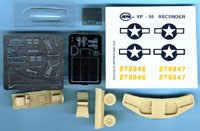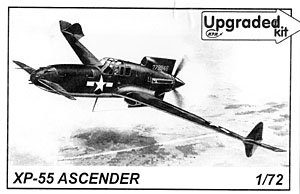Background The rather odd appearance of the XP-55 Ascender was the result of the influx of large amounts of money to the Army Air Forces in 1940. With the recognition that war was eminent, and that the U.S. Military was totally unprepared, the build up of hardware was finally funded. In a rather unusual move Wright Fields materiel Division asked the aircraft builders to start with a totally blank page and just try new and innovative ideas. When the paper results were evaluated, Vultee’s XP-54 proposals had won first and second place. Curtiss-Wright’s XP-55 ideas had third and fourth, and Northrop was fifth with the bug like XP-56. It should be remembered that these were paper proposals only, no flying hardware involved at this point. All three manufacturers were asked to continue with the project development-again no flying hardware. Curtiss built a ¼ scale, 600 pound, electric model to run tests on. The results apparently did not please the Army, and Curtis made the decision to proceed on their own, using company funds. The results were a full scale-flying model. This carried the designation Curtiss-Wright Model 24B. The fabric covered steel tube fuselage and plywood winged bird was shipped to Muroc Bombing Range for flight testing. As expected, the 275 HP Menasco engine was just about enough to push the thing into the air. The wind tunnel predictions indicated that the bird would not be recoverable from a spin, and directional stability was not good. As is usual with radical designs, changes were made and most of the control deficiencies were addressed and corrected. The predicted spin problems resulted in no tests being attempted to see if the bird would actually be recoverable. That would come later. The tests were completed in May of 1942 and Model 24B was shipped of to the wind tunnel at Langley for testing. Just three months later the Air Force approved a contract to build three XP-55s for flight testing. The Model 24B gamble had paid off! The first bird (s/n 42-78845) was assembled at Scott Field, in Illinois on July 10, 1943. Three days later it flew. The test program started revealing the usual problems that flight test is intended to find. Take off roll was excessive, stability was not especially good, especially stalls, and landings usually resulted in the nose gear being slammed down hard. On Nov. 15, 1943 Curtiss test pilot Harvey Gray proved the spin predictions to be very accurate. On the third stall of the day the airplane pitched forward onto its back and that was all she wrote. The engine promptly quit and after what must have been a very interesting 16,000ft. Gray said he had had enough and bailed out. One might speculate that the unacceptable stall characteristics proved the end of a very unusual airplane. The remaining two test birds continued to fly for a while but the end seemed inevitable. The end did arrive in December 1944.  The Kit The Kit
My understanding is this is the second edition of this kit, and the box states “Upgraded kit” I have not seen the first effort so can not comment on the changes. There are 30 parts on the usual somewhat heavy gray tree, many of them small minor parts. Also included is a resin cockpit tub, a simple seat, the main wheels and a wheel well in the usual tan resin. It looks like the resin wheel well will require considerable thinning down to fit into the wing. There are two small etched steel frets that include the inside of the main gear doors, instrument panel, ventral fin, a lot of small odds and ends, and a fold up nose wheel well box that is devoid of any interior detail. The etched parts should go a long way toward making what is a rather simple airplane into a nicely detailed model.
Unlike the fantastic little F3F-1 also reviewed this month, this one reverts to the usual humdrum vacuformed canopy.  The plastic parts have excellent surface detail, but seem to suffer from the usual rather thick overall appearance that most of the early limited run stuff has. Almost all the edges of everything have some fine flash attached. I also think all the flying surfaces could use some thinning down at least on the trailing edges. There are separate wing extensions outboard of the wing mounted rudders so you can build the thing either as an early or late test bird. From the limited amount of data I have, I think the small intakes just forward of the engine exhausts were only on the first prototype, and the wing extensions were added rather early on to all three airplanes. Surprisingly, the decals only offer serial numbers for the last two, and not the one the kit appears to represent. None of this is anything near a showstopper, as the small scoops are a slip of the knife removal and the wing extensions are provided. The plastic parts have excellent surface detail, but seem to suffer from the usual rather thick overall appearance that most of the early limited run stuff has. Almost all the edges of everything have some fine flash attached. I also think all the flying surfaces could use some thinning down at least on the trailing edges. There are separate wing extensions outboard of the wing mounted rudders so you can build the thing either as an early or late test bird. From the limited amount of data I have, I think the small intakes just forward of the engine exhausts were only on the first prototype, and the wing extensions were added rather early on to all three airplanes. Surprisingly, the decals only offer serial numbers for the last two, and not the one the kit appears to represent. None of this is anything near a showstopper, as the small scoops are a slip of the knife removal and the wing extensions are provided.
The choices of colors are really impressive! You get O.D. and Gray times two! The big variation is the two serial numbers. Oh yeah, and one has a black panel somewhat like an anti glare area and a black spinner. Conclusions This “upgraded kit” concept is a real mixed blessing. MPM is to be commended for trying to improve their products and the Grumman F3F-1, also reviewed this month, is an absolute jewel. This one on the other hand is still a step behind. It is a nice kit of a very obscure airplane and one would wonder about the market for doing it again. There are several more “upgraded kits” listed for next year and I would hope that MPM tries to really improve the basic injection trees rather than just add supporting stuff. Of course the extra fiddley bits are nice, but if the basic construction is still difficult then few get finished. The new canopy molding capability in the Grumman would be a real plus to replace the mediocre vacuforms of these older kits. Like most limited run efforts, this one will take some tender care to make it into the neat little funny looking airplane that will add variety to you collection. If a corner of your shelves is reserved for the odd balls and what-ifs of aviation, you need this kit. Hey!! Did anyone notice that I got all the way through this without ever making any rude comments about the name Ascender? | 









    |

 The Kit
The Kit The plastic parts have excellent surface detail, but seem to suffer from the usual rather thick overall appearance that most of the early limited run stuff has. Almost all the edges of everything have some fine flash attached. I also think all the flying surfaces could use some thinning down at least on the trailing edges. There are separate wing extensions outboard of the wing mounted rudders so you can build the thing either as an early or late test bird. From the limited amount of data I have, I think the small intakes just forward of the engine exhausts were only on the first prototype, and the wing extensions were added rather early on to all three airplanes. Surprisingly, the decals only offer serial numbers for the last two, and not the one the kit appears to represent. None of this is anything near a showstopper, as the small scoops are a slip of the knife removal and the wing extensions are provided.
The plastic parts have excellent surface detail, but seem to suffer from the usual rather thick overall appearance that most of the early limited run stuff has. Almost all the edges of everything have some fine flash attached. I also think all the flying surfaces could use some thinning down at least on the trailing edges. There are separate wing extensions outboard of the wing mounted rudders so you can build the thing either as an early or late test bird. From the limited amount of data I have, I think the small intakes just forward of the engine exhausts were only on the first prototype, and the wing extensions were added rather early on to all three airplanes. Surprisingly, the decals only offer serial numbers for the last two, and not the one the kit appears to represent. None of this is anything near a showstopper, as the small scoops are a slip of the knife removal and the wing extensions are provided.







